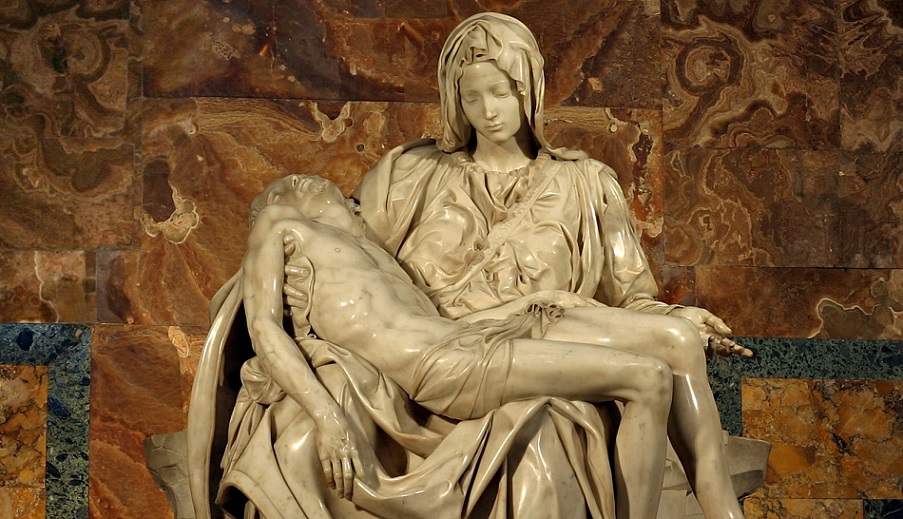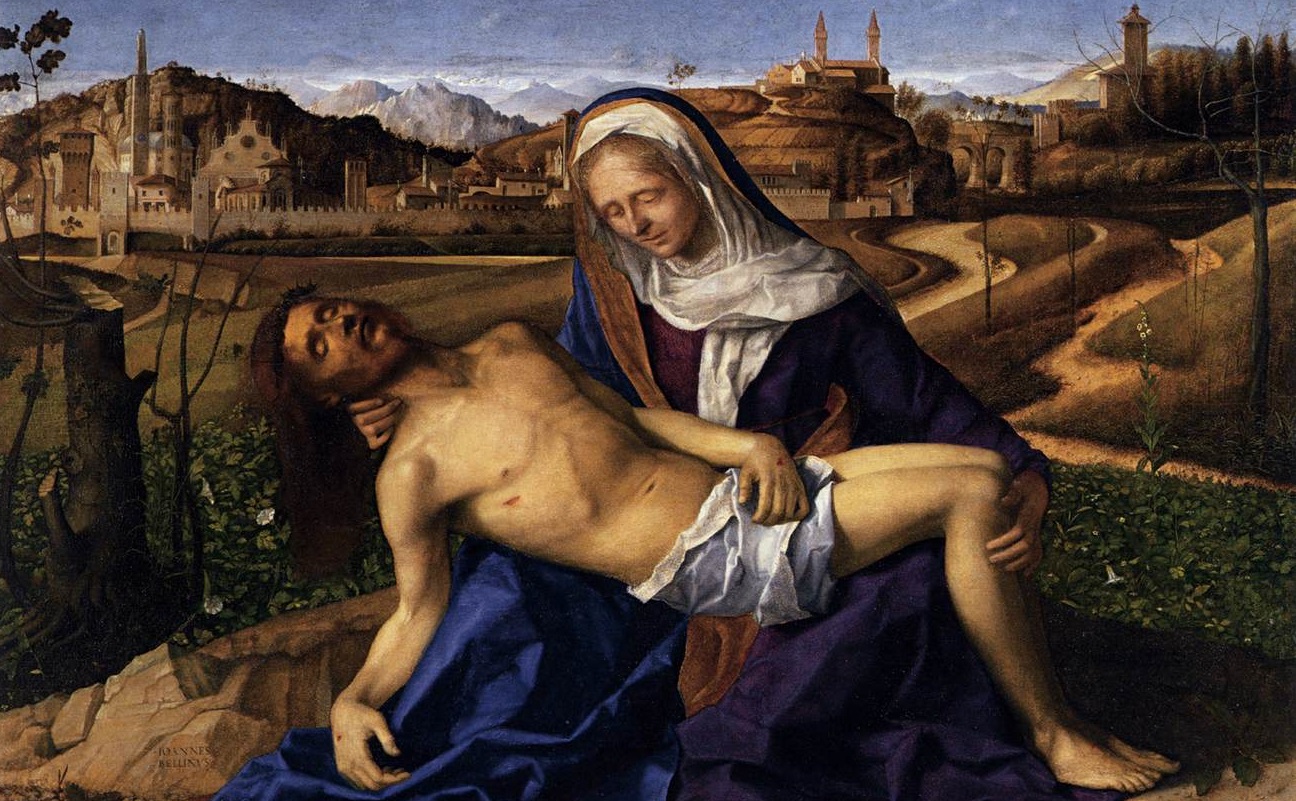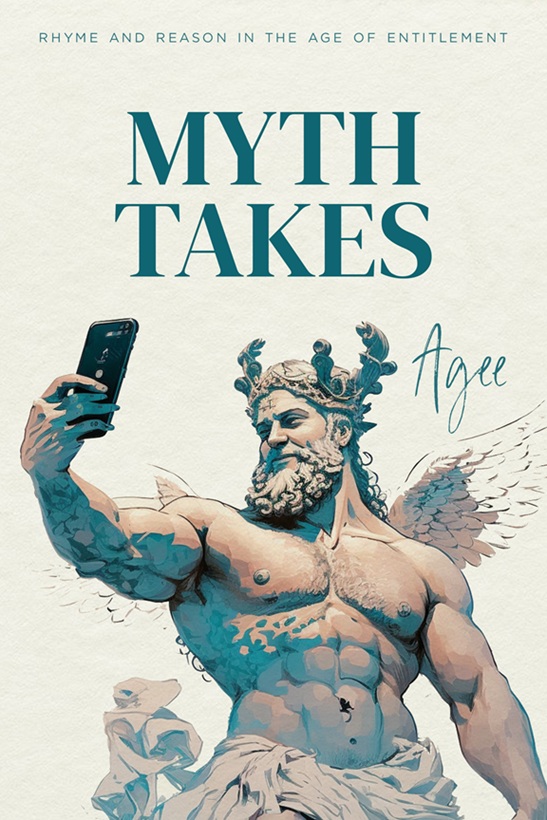My Cross
by Joe Tessitore
The shadow of my cross draws near and I recoil in abject fear!
Such agony I cannot bear –
to ponder it I do not dare!
I am a weakling; this I know. Its weight alone will lay me low –
to die its unforgiving death,
in searing pain, gasping for breath!
But Jesus Christ has made it clear -the only way to enter here.
These gates unlock; there is a key:
“take up your cross and follow Me.”
My epitaph, now carved in stone:
“He tried to carry it alone.”
Joe Tessitore is a retired New York City resident and poet.
Pietá

by Tonya McQuade
His lifeless body cradled in her arms,
She peers with eyes of sorrow at her son.
In Italy, a hundred times I saw
This image of Madonna, so undone.
Distraught, she wonders how it came to this;
How could his godly father let him die?
Examining his wounds, his body bruised,
She searches for a reason, questions why.
On painted wood and canvas, Mary cries;
In plaster, marble, stone, her son lies still;
On tapestries and vases, humbly veiled,
This piteous saint reflects upon God’s will.
In some, our Savior wears his crown of thorns;
In others, there’s a halo ‘round his head.
With just a cloth to hide his naked frame,
It seems the end has come, the Lord is dead.
Dear Mary ponders all this in her heart,
Yet knows her son had said he’d rise again;
She holds out hope, her fiery faith still strong,
That all this served a purpose, souls to win.
All frozen in that moment, so bereft,
These pietas, with sorrow, weigh us down –
So woeful, tortured, downcast, and forlorn,
As blood drips from Christ’s side and thorny crown.
If, seeing, viewers think this marked the end,
The last time that this mother saw her son,
It’s clear the story’s ending they’ve not heard:
That Jesus resurrected, victory won.
I’d love to see the look in Mary’s eyes
When to his mother he again appeared –
The love, the joy, the peace she must have felt,
Replacing all she must, at times, have feared.
Most famous is the marble Pietá
That stands inside St. Peter’s, bathed in light;
A youthful Mary, in a full gown draped,
Holds tenderly her son, cold, stony white.
Carved by the sculptor Michelangelo,
The statue helped to launch his bright career –
The tenderness he captured in her eyes,
The way they, real and natural, appear.
So many have portrayed the Pietá,
Some adding saints and patrons to the scene –
In frescoes and upon cathedral walls,
On ceilings, tiled floors, and painted screen.
Their many varied forms inspire awe,
From ancient times to this, our present day.
I’m happy that, while traveling, we saw
So many as we journeyed on our way.
Tonya McQuade is an English teacher at Los Gatos High School in Los Gatos, CA, and lives with her husband in San Jose, CA. She has been writing poetry since fourth grade and is currently a member of Poetry Center San Jose. She has been published in Poetry.com’s America at the Millennium: The Best Poems and Poets of the 20th Century, Pushpen Press’s Three: An Anthology of Flash Non-Fiction, and California Teacher Association’s digital California Educator.
The Pietá
The mother holds
Her son, now slain.
She’ll never speak
With Him again.
Her youthful look
Conceals her age.
Perhaps a sign—
Her holy stage.
She cradles Him
As if newborn,
A sense of wonder
Beyond the scorn.
Three blessèd years
Creation served.
This brought Him thorns,
Pain unreserved.
He met the test,
A test Divine.
At last with Mary,
In safe recline.
She looks upon
Her Son’s own face.
The boy she loved,
So filled with grace.
She asks her God
“Why’s this my role?”
“And why my Son
Has paid this toll?”
Abiding faith
Makes her strong.
As they sing
His funeral song.
She says goodbye,
With arms and eyes,
His trial now past,
His prospects rise.
Two thousand years
From this one scene,
His time on earth
Still makes souls clean.
We men of faith,
We look for signs.
Is God for real
For all our times?
The answer found
In this true art,
Trust in God—
Press Son to heart.















Joe, this is excellent! No, it’s not empty, sugary praise; it’s sincere! Your talent continues to develop, and it’s great. I’m amazed at the swiftness of your compositions.
Tonya: Your descriptions are so vivid I think I can see what you see.
Thanks. The exhibit of Pietas we ran into at Sforza Castle in Milan was quite overwhelming and beautiful.
May I make a suggestion? On the SCP’s homepage, I saw “My Cross by Joe Tessitore …” Of course, it’s always a treat to read a J. T. poem, and this one was no exception. However, from the homepage, there was no indication of Tonya McQuade’s work also appearing. Therefore, I was wondering, when SCP does a theme (such as Good Friday) featuring multiple poets, how about listing the names of all the featured poets before offering a sample of the first poem? Is this possible and, if so, how does everyone feel about that?
An excellent idea, E. V. I have updated the homepage.
Regards,
Evan
Thank you. Hey, fellow poets of SCP: Do you also take “screenshots” of your online pubs.? (For example, if Tonya would like to take a “screenshot” of today’s SCP Homepage, it would help if her name were also listed as one of today’s featured poets.). Just a thought; please, as usual, feel free to express your opinions.
Sometimes the exclamation “Good God” is not a swear.
Mr Tessitore: you’ve served Him well and lifted up many this day.
Happy Easter to all. These two poems have rekindled my faith in the resurrection, and have allowed me to feel that I have, in some way, been resurrected myself. It’s sad that Easter comes only once a year. Every day should seem like Easter for a believer in the incarnation of the great I Am, His death, and his ultimate overcoming of it. That’s what it means to be part of the great European tradition that has given us so much great poetry. Call me Euro-centric if you want, but why else are we gathered here? What other culture is capable of inspiring such depth of faith without the taint of oppression and violence? Yes, Christians, in the dark past, were fully able to commit atrocities in the name of God, but this is not so among us gathered here today. Love thy neighbor, and improve thy neighborhood.
I’ve recently remarked on these pages about the seemingly boundless propensity of some on that side of the pond to throw commas around like confetti; and the injurious effect this can have on diction.
The clearest of clear examples of this can be found in the above piece Pietá: with the comma at the end of L2 crying out to be replaced with a full-stop.
As it stands (with the comma), the diction can conceivably be read as: “She peers with eyes of sorrow at her son, in Italy”.
Of course, once one’s read L3 and L4, they’ll quickly deduce that the ‘In Italy’ refers to where the image of Madonna was seen . . but the reader shouldn’t be asked to guess the author’s intentions; the reader should be guided by the grammar. In this case, the potential stumble could so easily have been avoided if it were to simply read as: “She peers with eyes of sorrow at her son. In Italy, I saw this image of . .” They’re two completely different sentences . . and they shouldn’t be separated by anything less than a full-stop.
After that minor hiccup, I was pleasantly surprised to go on and find the rest of the poem to be grammatically immaculate. Further, it’s got a fluid, easy flow about it from start to finish, which is testament to the exemplary diction throughout; and the thoughtful and fluent way in which it was written.
In view of my overall admiration of what is an otherwise faultlessly fully-rhymed poem, I was mildly disappointed to find the (seemingly lazy) attempt to rhyme ‘again’ with ‘win’ (regardless of whether ‘again’ is to be pronounced as ‘gane’ or ‘genn’). It surely wouldn’t have taken too much extra effort to search for a full-rhyme: to maintain the poem’s consistency; even if it meant re-arranging the whole stanza. Within about 200 seconds, I came up with an alternative:
‘She holds out hope, her fiery faith still strong;
Her confidence in his word will remain’.
All in all, a nice poem . .
. . as is ‘My Cross’, with the clever wording of L3: “To ponder it I do not dare” . . and the highly-effective couplet at the end. But I can’t help feeling that the exclamation-marks at the end of lines 1 and 6 are superfluous.
In ‘The Pietá’: the 7th stanza contains unclear english-usage: “And why my son has paid this toll?”. We don’t speak like that. We’d say it as: ‘And why has my son paid this toll?’
I can’t be sure: but I also feel that it doesn’t require speech-marks before the word ‘and’; and no question-mark after the word ‘role’ . . ‘cos it’s only one thing being said by the same person. Thus, it could (should?) read as:
‘She asks her God:
“Why’s this my role;
Why has my son
paid such a toll?”‘
I’m not sure of the author’s intentions with the meter, but . . . !
Hi Monty – Thanks for your comments on my poem. The punctuation was printed incorrectly in the first two lines – I noticed yesterday and almost sent an email to Evan, then didn’t (I guess I should have). Somehow, I originally sent him the poem with the first two lines transposed (I had moved them around when I was still tweaking the poem), and he pointed out the error. I said for him to change them before publication to the order you see now, but apparently he did not change the punctuation. So, I fully agree – the first line should have a comma at the end; the second line, a period. I’m glad you appreciated the rest of the poem. I guess it’s my California accent, but to my ear, “again” and “win” rhyme. Your suggestion is certainly another option. Thanks again – and Happy Easter!